By Carolyn Edlund
What’s the secret behind creating art that inspires interest, excitement and conversation?
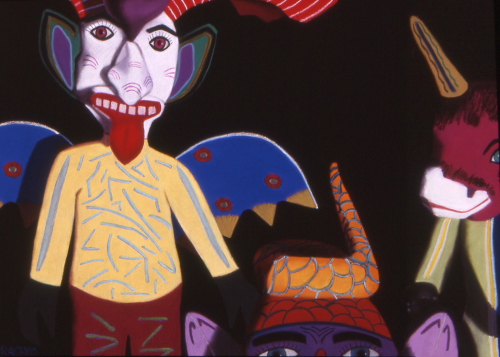
“Paranoia” 20″×26″ Pastel, 2009 by artist Barbara Rachko
In my everyday work, I’m exposed to a lot of work that artists are currently making. And in looking at artwork every day, I see a lot of sameness. Similar subject matter, similar styles and themes. It can become a blur after a while. Yet many artists want their work to be memorable, to shine – and to stand out from the pack.
What gives art that “Wow factor” that causes your audience to sit up and take notice? What is that elusive quality that transcends the usual and makes your work truly remarkable? Seth Godin defines remarkable as being “beyond the edge”. Would you agree?
Does your work elicit remarks, and start conversations? Consider these artists, whose work is noteworthy:
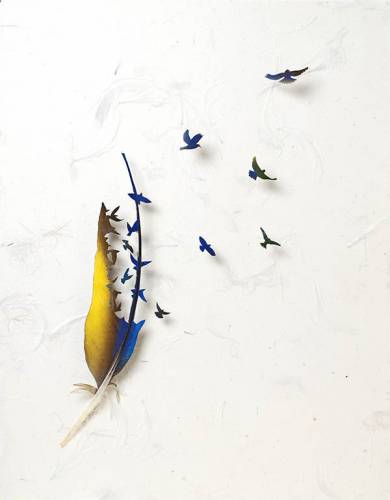
“Dance, Macaw Flight” (award to Tony) Blue and gold Macaw feather, 14″ x 11″ by artist Chris Maynard
Element of Surprise
Chris Maynard’s work is remarkable in large part because of the unusual material he works with – feathers. Add to this the complexity of working at a very small scale. Using eye surgery tools to cut and manipulate each element, he creates scenes depicting birds, often with a theme of transformation echoing the way he has transformed the feathers themselves.
Glen Kessler’s paintings are remarkable because they are not what they appear to be at first glance. Every abstract landscape turns out to be a closeup of a computer motherboard. His body of work makes a statement about technology integrating into every aspect of our lives.
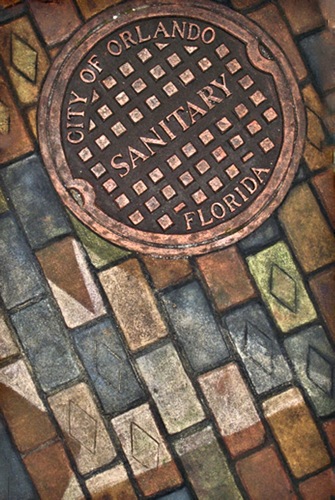
“City of Orlando” sculpture relief 48” x 31” x 3” by artist Bobbi Mastrangelo
Finding a Niche
Artist Bobbi Mastrangelo has created her own remarkable body of work based on sewers and drains, which are not popular subjects with artists. She has unswervingly devoted her career to recognizing the unseen beauty in grates, manhole covers and other mundane parts of publicity utility infrastructure. Her work has garnered an audience in that niche, and also landed her art in several museums devoted to the industry.
Mark Schwartz paints watercolors of high heels, and is widely known not only because his work appeals to shoe lovers, but his background as a shoe designer fits in perfectly with his theme. He has broadened his audience by doing what he does very well, understanding why his work is loved, and why it sells.
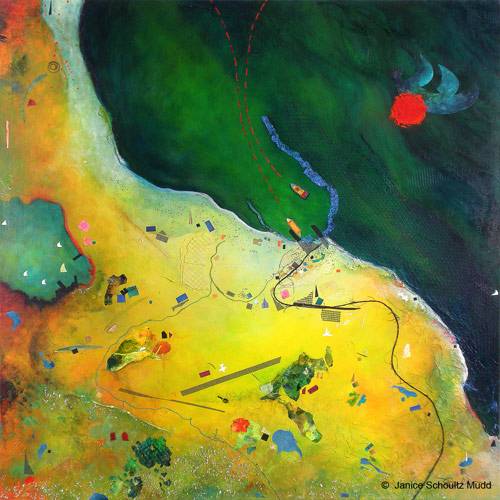
“Island Summer” by artist Janice Schoultz Mudd
Signature Style
Memorable artists often exhibit a highly recognizable style which is theirs alone, and produce a considerable body of work in that style for greater impact. View artist Barbara Rachko’s colorful and vibrant Latin-inspired emotionally charged images and you’ll know that when you see her work again, you will recognize it.
Janice Shoultz-Mudd paints serene aerial landscapes, remarkable not only for their beauty, but the concept that inspired them – the earth as viewed on Google maps and from the Hubble Telescope. This style not only appeals to the art lover, but those left-brained potential collectors who can see how she transcends the mundane map and makes it into art.
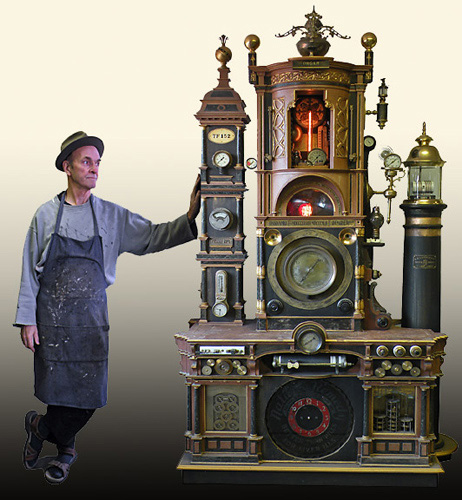
Artist Roger Wood with one of his large scale clocks.
Power of Personality
Free spirit Kat O’Sullivan of Katwise has a huge fan base for her popular handmade capes and costumes, and a backstory that draws in followers. As a world-traveling hitchhiker who once drifted from one Grateful Dead concert to the next and now owns a rainbow house, her story is an integral part of the purchase of her work.
Humble and unassuming, artist Roger Wood expresses an irresistible eccentricity in his work. His love of old gears, clocks and gadgets inspires him to create fantasy assemblages that resonate with fans. Roger’s public persona is that of a mad inventor with a sense of childlike wonder.
Remarkable art may have any or all of these characteristics, or others. It may be connected to a cause, be monumental in size, or the result of an innovative technique invented by the artist. Remarkable art works on several levels, with a concept that is deeper and more meaningful than what initially meets the eye.
Which artists come to mind who you think are remarkable? Why?


These are actually tough questions to answer if we consider the art market as a whole. For example, you may find something that I consider remarkable (and marketable) to be simply horrid. Look at the late Thomas Kinkade. Clearly he had a HUGE following — many people found his work to be remarkable… BUT you will never find his work hanging in my house. I think he was great at what he did… but his work does not speak to me.
Think about Andy Warhol. Clearly a lot of people feel that he was a remarkable artist who created remarkable art. He is still one of the top selling artists on poster / print sites. I ‘get’ what he did… but I don’t like it enough to hang a reproduction in my home. Does that mean I have bad taste? I don’t think so. I just know what I like.
As for work that I find remarkable… it is still tough to put my finger on one definition. I have an eclectic collection of original art at my home. In a sense, my collection is all over the map style-wise, medium-wise, you name it. BUT specific artists do come to mind when I think about remarkable art / artists in general. Laurie Lipton would be at the top of my list… her drawing skills are remarkable — no, mind blowing — and I really respect what she does as an artists… taking a medium that a lot of people look down at (you’ll find that a lot of people don’t consider drawings to be ‘finished works of art’ — and taking it to the next level.
Brian, I get that you like what you like – so do I!
It’s true that artists whose work is remarkable may not be marketable, or desirable, or even appealing. Thomas Kinkade certainly had his following – the sheer force of his tenacity and marketing prowess was worth of remark in itself.
Still, I’d like to see more artists taking the chance to make their work remarkable rather than languishing in a state of sameness or safety. It takes awareness, devotion and deliberate consistent steps to create a body of work that breaks out from the rest of the pack. When I see that, I find it refreshing.
Thought-provoking post, Carolyn. I agree with Brian Sherwin’s points about the subjectivity of art, and also have a hard time pinning down why some art speaks to me louder than other art.
For me, remarkable art evokes a visceral excitement. As an active artist, budding collector and participant in the art world, I see sooo much work that doesn’t excite, move, or provoke me. When I do, it’s a real thrill. Perhaps it’s due to a bold style, a twisted point-of-view, or a unique approach, or maybe it just makes me smile.
In fact, when viewing art, my partner and I have three levels of attention:
1) Mild Appreciation
2) Really Like
3) Really Like AND Would Totally Buy and Hang In Our Home
The difference between 2 & 3 is that elusive “X” factor that you speak of in your post.
Nikolas, since you are an artist who undoubtedly sees a lot of artwork out there, have you found over time that it takes more to create that “visceral excitement” that you referred to? Do you have more appreciation for art? Or do you feel “jaded” at all?
I don’t think it takes more to generate excitement, nor do I feel jaded (though I do notice the “sameness” you mention in your post). While I can appreciate the highbrow, the lowbrow and everything in between, there are definitely certain elements, styles, techniques and approaches that leap out and arrest my attention. Thankfully, too, ‘cuz that’s what keeps the world of art so interesting!
We’re wonderful, remarkable creatures and thanks to each other we’re able to make amazing, wonderful things. It’s never ever been easier to see that in this world than it is right now. Go ahead, jump on the web and try to find something cool. Then take awe by considering it all happens next to never ending injustice and human suffering. I’ve never been able to get my head around it personally.
Carolyn – I think there’s a danger in looking for the ‘remarkable’, quite apart from the ‘subjectivity’ that others have mentioned. One thing I notice on social media sites is that there seems to be a vying for ever more remarkable images and sometimes quality can get lost in the quest to stand out for being ‘remarkable’. In fact, I’m tired of it! On the other hand, some images need time to sink in. They may not seem at all remarkable at first and we may never know what it is that appeals to something in us – or at least, we may not be able to put it into words. Many of my favourite paintings are of everyday, decidedly ‘ordinary’ things, painted in an ‘ordinary’ way that doesn’t jump out and say, ‘look at me, I’m remarkable!’ But they have some kind of remarkability all the same otherwise why would they become such favourites? It’s just not always easy, or even desirable, to try and pin that remarkable quality down. Some things resist being labelled and that’s fine with me 😀
One thing no one has mentioned here is as an artist be yourself. Put you in your work. I find it distasteful to create for an audience. Who knows what they will or will not find amazing. Each of us is unique, push that unique be yourself button and keep creating. The other thing is the fear factor, loose all fear and just go for it. If we, as artists, sit around trying to figure out how to be special we are wasting our time. Go out in the world and just do what you like and do it the best you can, forget about what that person looking over your shoulder thinks when you are doing a watercolor of a mundane corner instead of the famous Cathedral. This fall, in Bordeaux France I sat on the street and did a watercolor of a local shop. A man told me I should paint the Cathedral. My response was that everyone paints the Cathedral. That meant I had crossed a line, I did what “I” found important, that is key to being an artist. You don’t have to look for it you already have it inside of yourself.
Marilynn, I can relate to your experience in Bordeaux. I went to Brecon to take photos of the cathedral to paint – and ended up painting a flowering weed that was growing in one of the corners outside!
What is remarkable art is different for each person. Art is subjective – that means no two people are going to see art in quite the same way. I think whether art is “samey” or not also depends on who’s looking at it….I tend to think that someone who is exposed to a vast amount day in day out is going to become more jaded than, say, someone who frankly isn’t as exposed but who still appreciates the subjective beauty of a particular piece of art that speaks to them. There seems to be a trend (and maybe it’s because of the proliferation of and on social media sites) to compel people to “specialize” to “be different” or “as this post suggests “do something remarkable”… do “something different” to satisfy some other person or trend or to try and stand out – for someone else. I see a lot of photography – mostly because I am on several social media sites and I can see how it could be concluded that there is sameness… but I realise that each photograph is unique and was probably remarkable to the artist – and that the majority of people don’t look at tons and tons of art or photography, just art they like.
There is some art that people rave about that leaves me cold… and things that stand out for me and that I love which perhaps might not be considered at all remarkable to others. And that’s fine by me. I do think that it’s good to challenge the way we do things. However I think what’s more important is that artists should be true to themselves and go where their creative spirit leads.
Well said, Nicky – thanks for taking the time to put together such a thoughtful reply!
Thanks, Carolyn, for the thought-provoking post.
Hi Carolyn,
You cover an amazing range of topics on art appreciation and inspiring artists.
I am honored to be included in “What Makes Art Remarkable”
“Grate Wishes!”
Bobbi Mastrangelo
Bobbi, I always enjoy including your work, because it is ever remarkable and different!
It’s all about personal vision. I paint subjects I think are interesting. My art is who i am. Some people may find my ‘style’ interesting, some won’t. But i love so many other types and styles of art. That’s what’s ‘remarkable’-it’s all out there-so many personal visions to choose from.
Carolyn, a few years ago I had enough of my “traditional style” paintings and decided it is time to explore and exploit something more fun, entertaining and thought provoking. So I became a Chess-Painter in a way that my paintings usually have some element of Chess in them and always have a story to tell. I stuck to my niche as a Chess-Painter and now it is an unbelievable experience to see how many of my paintings have branched into series — a theme within a theme — that in itself is remarkable to me. Skeptics turning into converts and collectors –that is remarkable to me and lastly, my own family finally respecting what I do and supporting me as an Artist — that just takes the cake. Of course I agree with Seth Godin’s definition of being remarkable. However, I would like to add that if you look around and notice people who do “remarkable” work (artwork) don’t just wake up one day and decide to become a “Purple Cow”. They take their natural talent and work on it till they master it while the rest of the world sleeps or waste their time in chat-rooms or in front of the TV. People who are remarkable in one area may very well be remarkable in other areas too. They just don’t have any tolerance for being “average”. If someone were to ask my friends from 4th grade (yes, I have them on my facebook) they will confirm that I was a “Purple Cow” even back then. As for what Artists come to my mind as being remarkable? I find paintings of Sandra (Kiki) Thome, Jeff Faust, John Payne, Sunita Khedekar and Elisabeth Kopjar remarkable as they have taken representational art to a whole new level. Each of them has a distinctive style and originality that makes them a “Purple Cow”. You can see their paintings and interviews on my Art Blog.
Thanks for adding your comment, Roopa and your amazing story! I’ll definitely check out your website to see your remarkable art.
A year ago Carolyn when I commented on your post I did not have a website to showcase my work (did not occur to me that I needed one) but now I do (and I have a gut feeling that you are already aware of my work). I am grateful that you wrote this post for I have read it over quite a few times. It should be a MUST READ for all aspiring artists as it is timeless and highly informative. I tweeted it to keep it alive.
It’s interesting to me that you should bring this issue up. I’ve pondered this at length myself on my blog. What makes art- “Art” with a Capital A, What is an –ism or art style, finding your voice as an artist, And what role does “brand” play in making a living in art, are all questions I’ve been researching and debating. And I’ve got to say that Ive come to the conclusion that there is an inherent connection in these things: voice, brand, style and ART. What is art is the overlying main question – and the terms voice, brand, style, (ie. ism) all of these things are synonyms for finding/defining your way. These the words or vocabulary used by be various fields: the art field, the marketing field the fine art field, the art history field that define the thing we are all seeking- ART.
I think you are asking one of the great philosophical questions of the field- what is art? This is certainly a hard question. Thank you for the nice intellectual question.
I agree with Brian Sherwin’s comments. I don’t think I can add to this discussion that hasn’t already be said.
Je. Ne. Sais. Quoi.
“Though we have an hundred tongues/we are still dumb/despite our art;/
But oh, though it slay speech/speak how it long lay/in the placeless land/
and rolled It’s eye/in dream.”